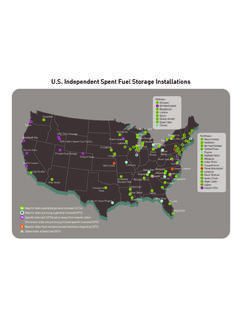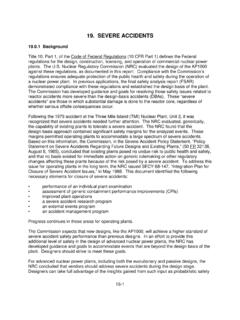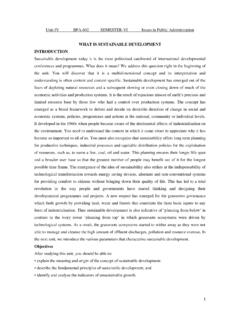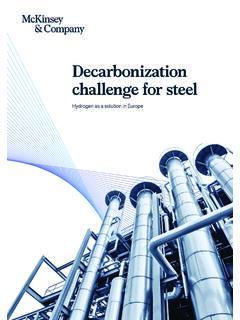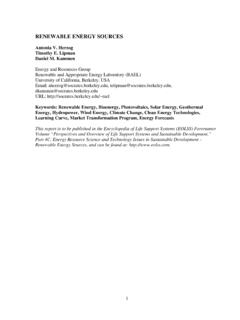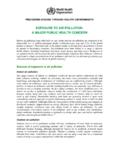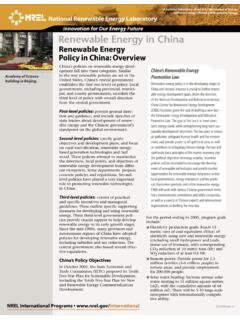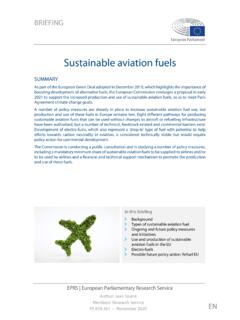Transcription of Hydropower Greenhouse Gas Emissions
1 Hydropower Greenhouse Gas Emissions State of the Research February 14, 2012 AUTHORS William Steinhurst, Patrick Knight, and Melissa Schultz Table of Contents 1. INTRODUCTION .. 1 A. PURPOSE AND SCOPE .. 1 B. KEY FINDINGS .. 1 2. BACKGROUND .. 4 A. HYDROELECTRIC GENERATION .. 4 Measuring Electrical Output 5 B. Greenhouse GAS Emissions .. 6 C. LIFE CYCLE ANALYSIS (LCA) OF Emissions .. 7 D. METHODOLOGY AND SOURCES .. 8 3. RESULTS .. 9 A. GHG Emissions RANGES FOR VARIOUS TECHNOLOGIES .. 9 B. SOURCES OF Emissions AND VARIABILITY .. 11 Indirect Emissions 11 Direct Emissions 12 4. DISCUSSION .. 15 A. BEST PRACTICES FOR ESTIMATING GHG EMISSION FROM Hydropower .. 15 B. DISPLACED GENERATION ISSUES .. 16 C. REDEVELOPING, REPOWERING AND UPGRADING EXISTING Hydropower SITES .. 18 D. HOW CONCLUSIVE IS CURRENT RESEARCH IN ESTIMATING GHG Emissions FOR Hydropower COMPARED TO OTHER ENERGY SECTORS?
2 18 5. CONCLUSIONS AND RECOMMENDATIONS .. 20 6. BIBLIOGRAPHY .. 23 Hydropower GHG Emissions 1 1. Introduction A. Purpose and Scope Hydroelectric generation of electricity ( Hydropower ) is commonly thought of as renewable, sustainable , and lacking in emission of atmospheric pollutants; however, these assumed benefits are rarely evaluated critically in the context of policymaking, as new reservoirs and dams are rarely proposed in North America, outside of Qu bec and Labrador. This report reviews the state of information regarding one key policy consideration: how Hydropower stacks up against other technologies with respect to Greenhouse gas (GHG) Emissions including the life cycle Emissions from the construction and operation of generating capacity. An important aspect of the analysis is a comparison of not only the typical amount of GHG Emissions from each technology, but a presentation of the range of values that may be observed.
3 The report also discusses concerns about the way GHG Emissions are measured, especially in the case of Hydropower , and best practices for doing so. Finally, the report discusses a specific policy consideration: the relative trade-off (from a GHG emission perspective) of Canadian Hydropower imports versus other energy options for New England. This report approaches GHG emission estimates by critically considering a variety of primary sources for the various technologies. Section 2 provides a brief review of Hydropower s role in the electric industry in North America; a discussion of the types of GHG Emissions from Hydropower and other electric generation technologies; and an explanation of GHG measurement concepts. Section 3 presents the range of estimates of GHG Emissions from existing Hydropower facilities and compares those Emissions to those from facilities using other technologies, including oil, natural gas, and coal.
4 Section 4 discusses various issues that arise in the consideration and understanding of the GHG emission results and the methodologies used in the literature, including certain important caveats that apply to those results. Section 5 offers recommendations for use in policy-making contexts, including planning around additional Canadian Hydropower imports. Section 6 lists the primary source material used. B. Key Findings Based on the literature reviewed, we find that Hydropower development does emit Greenhouse gases (GHGs), but the rate of Emissions per unit of electric generation from Hydropower (excluding tropical reservoirs) is much lower than for fossil fuel This conclusion is discussed in more detail in Sections 3 and 4. Lifecycle GHG emission ranges for Hydropower and fossil fuel technologies are presented in Table 1 below. 1 Tropical reservoir issues will be revisited below, but unless otherwise specifically stated, this report will discuss non-tropical reservoir Hydropower .
5 Hydropower GHG Emissions 2 Table 1. Approximate Lifecycle GHG emission rate ranges by fuel type for electricity generation2 Technology GHG Emissions rates (kg CO2eq/MWh) Hydroelectric facility (run of river or non-tropical reservoir) 152 Hydroelectric facility (newly flooded reservoir only, boreal) 160 250 Hydroelectric facility (tropical reservoirs) 1300 3000 Natural gas-fired power plant 400 500 Oil-fired power plant 790 900 Coal-fired power plant 900 1200 The largest sources of GHG Emissions for Hydropower are the construction of the facilities, and biomass decomposition from reservoir flooding. In addition, there are ongoing net differences between the carbon uptake and respiration of the pre-flooding and post-flooding biomes and water columns. Along with methodological disparities, biomass decomposition is the largest source of uncertainty in the GHG emission estimates; the rate of decomposition is also highly dependent not only on the climate zone ( , tropical, boreal, etc.)
6 , but also on the specifics of the flooded biome ( , old river, wetlands, forest, etc.). Emission uncertainties from biomass decomposition may remain large and site dependent as the relevant modeling is complex. For fossil fuel technologies, the main sources of variability relate to potential carbon capture / sequestration technologies (for new facilities), whose efficiency, effectiveness, and infrastructure requirements are speculative, and a variety of operational issues that affect the amount of electricity produced over a plant s lifetime for a given amount of construction / decommissioning Emissions and for a given amount of fuel burned. Overall, life cycle GHG Emissions per unit of electric energy production are lower for Hydropower than for fossil fuel sources (though in some cases net hydro emission ranges may be nearly 2/3 those for a natural gas power plant), and may be in the same range as other renewable sources and nuclear (though reservoir hydro emission ranges are likely higher than those for at least some other renewable options, depending on the specific site and the level of indirect Emissions , which are not included in Table 1 above).
7 Recent studies have further shown that, during the first several years after reservoir creation, hydro GHG Emissions may be higher than annual Emissions for some fossil fuel sources. This is surprising, given the lower GHG emission ranges reported in earlier studies. The ultimate level to which newly flooded reservoir Emissions decline over time is uncertain. An important GHG policy question in comparing potential new generating facilities or imports is but for the new facility or import, what Emissions would have occurred? This requires consideration of what generators (existing or new, within or without the regions in question) will not 2 Note that ranges for all technologies except hydroelectric facility (tropical reservoirs) and hydroelectric facility (newly flooded reservoir only, boreal) are estimates based on figures in Raadal et al.
8 (2011). Raadal et al. (2011) does not contain a thorough review of tropical hydro emission rates; for this emission source, Weisser (2006) and Demarty and Bastien (2011) were used. Estimates for a newly flooded boreal reservoir were derived by Synapse based on data contained in Teodoru et al. (2010) and are explained further below. The units used (kg CO2eq per MWh) are explained below. Hydropower GHG Emissions 3 be built or will run less often if the facility under consideration is built. One approach is to examine displaced or avoided generation by looking at the marginal Emissions in the affected region or regions. Due to their high fuel cost and the ability of some of them to ramp up and down fairly quickly, natural gas generators are typically the last to be dispatched in any given hour in both New England and New York. Therefore, marginal Emissions in both regions are about the same as for natural gas generators.
9 However, one study found, .. increased export of hydroelectricity by Hydro Qu bec to the United States likely was a contributor to increased generation from fossil-fuel-fired sources in other regions in Canada. 3 3 Steenhof, Paul, and Weber, 2011, An assessment of factors impacting Canada s electricity sector s GHG Emissions , Energy Policy 39, 4089 4096. Hydropower GHG Emissions 4 2. Background A. Hydroelectric Generation With global demand for electric energy expected to grow steadily over the next 25 years, Hydropower is being looked to as an important source of global energy Demarty and Bastien (2011) note that the increase in energy demand worldwide, in addition to raising concerns about GHG Emissions , have put hydroelectricity in the forefront of green energies. Indeed, according to Bates et al., 2008, hydroelectricity is the only non-intermittent renewable energy and could therefore sustain the development of other renewable energies.
10 5 Hydropower has several special features that affect its role in the generation mix, beyond its energy output and capacity. For example, it does not necessarily rely on outside sources or fossil fuels to restart after an outage, making its existence, even in small amounts, quite valuable as part a utility s plan for recovering from a blackout (its black start plan ). Hydropower can start up on short notice, as it does not depend on gently warming up boilers or turbines, and can ramp up or down in output quite rapidly. Hydropower facilities with ponding ( , not run of river units) can serve an energy banking function, helping to level load and price spikes. Hydropower sources with ponding are typically energy limited rather than capacity limited. That is, the amount of energy produced in a time period, say a year, depends on the amount of water available, not just the size of the unit. These factors all affect the value, economically and from an engineering standpoint, of Hydropower .







